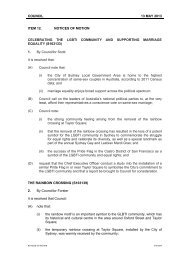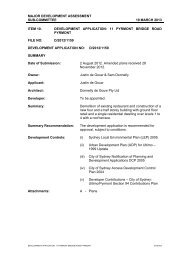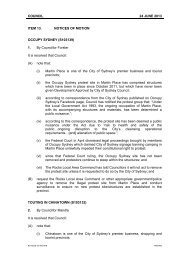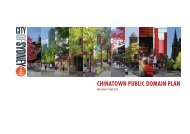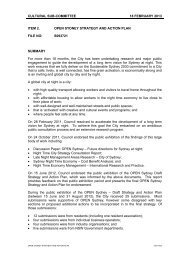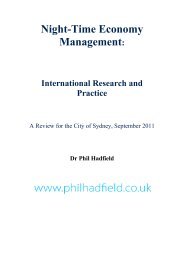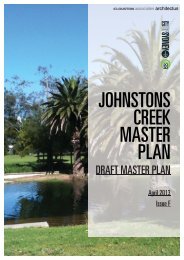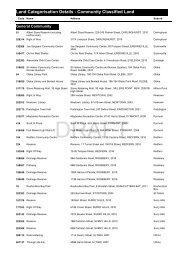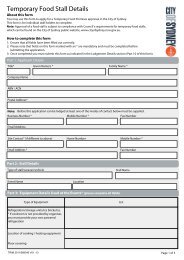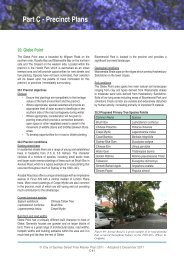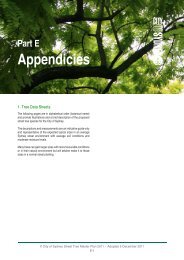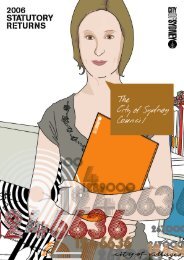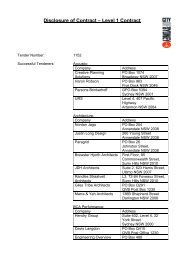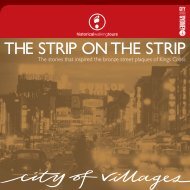Histories of Green Square - City of Sydney
Histories of Green Square - City of Sydney
Histories of Green Square - City of Sydney
You also want an ePaper? Increase the reach of your titles
YUMPU automatically turns print PDFs into web optimized ePapers that Google loves.
<strong>Histories</strong> <strong>of</strong> <strong>Green</strong> <strong>Square</strong><br />
was left over would be brought back for the group. 7<br />
The Europeans were at first scathing about these simple<br />
and unlikely water craft, but the Aborigines were so adept<br />
at handling them, they were soon impressed by their skill.<br />
Women who went fishing would take their children out with<br />
them in the canoes. Captain Hunter <strong>of</strong> the Sirius wrote with<br />
some wonder—<br />
42<br />
A miserable boat, the highest part <strong>of</strong> which was not<br />
more than six inches above the surface <strong>of</strong> the water,<br />
washing in the edge <strong>of</strong> a surf, which would frighten<br />
even an old seaman to come near in a good craft. 8<br />
The freshwater wetlands and sandhills <strong>of</strong> the <strong>Green</strong> <strong>Square</strong><br />
area would also have been a veritable storehouse <strong>of</strong> food.<br />
Benson and Howell have identified a number <strong>of</strong> wetland and<br />
dune species which could have provided food:<br />
In the swamps, Eleocharis sphacelata, Phragmites<br />
australis and Triglochin procera provided edible roots<br />
and tubers. In the heath and shrubland on the sandy<br />
dunes were sharp-leaved plants with small edible<br />
succulent fruits, members <strong>of</strong> the heath family, Epacridaceae.<br />
Shrubby geebungs…Currant Bush…Native<br />
Cherry, and the semi-parasitic Devils Twine…all<br />
produced small edible fruits. Ground orchids…and<br />
small lilies…provided edible tubers. Flower spikes <strong>of</strong><br />
Banksia and the Xanthorrhoea or Grass Tree were rich<br />
in nectar. 9<br />
Freshwater swamps, creeks and lagoons were also rich in<br />
resources <strong>of</strong> fish (mullet, Australian Bass, Macquarie perch,<br />
eels) shellfish (several species <strong>of</strong> freshwater mussels), crayfish<br />
and yabbies, tortoises, platypus and water rats. The area<br />
teemed with water birds—swans, ducks, ibis, egrets, water<br />
hens, quail and many more. In the Hawkesbury/Nepean area<br />
to the west, eel traps made <strong>of</strong> hollow logs and woven bird<br />
traps were set to catch food—perhaps these devices were also<br />
made and used in the swamps <strong>of</strong> <strong>Green</strong> <strong>Square</strong>. 10 The area was<br />
also a great haven for insects—including mosquitoes, flies and<br />
sandflies which plagued the Europeans in their hot clothing.<br />
Most coastal Aboriginal people did not wear clothing, but<br />
they covered themselves in fish oil to ward <strong>of</strong>f mosquitoes and<br />
the cold. Some observers reported that Aborigines would put<br />
fish entrails in their hair, so that the oils would slowly seep out<br />
and cover their bodies. 11<br />
The Eora moved about their country hunting and collecting,<br />
‘cleaning up’ or maintaining it and taking shelter in overhanging<br />
caves or bark huts. A group <strong>of</strong> these huts stood on the<br />
Cooks River near Botany Bay. Eora paths criss-crossed the<br />
land. People don’t seem to have moved outside their own<br />
areas <strong>of</strong>ten, apart from for travelling to major ritual or gatherings,<br />
or a whale feast. However trade goods moved readily<br />
from group to group across large distances and along wellknown<br />
routes. One major item <strong>of</strong> trade from the western<br />
parts <strong>of</strong> <strong>Sydney</strong> was stone—such as smooth basalt pebbles,<br />
chert, mudstone, quartz and red and yellow silcrete. These<br />
were worked into sharp tools and weapons. 12 Some tools were<br />
used to engrave pictures on sandstone platforms and in caves,<br />
and many still survive in the national parks which encircle<br />
the city. They depict fish and animals, people, tools and ‘sky<br />
heroes’ or spiritual beings. 13<br />
Land was not only a source <strong>of</strong> food and shelter—it was also<br />
the source <strong>of</strong> identity and spiritual beliefs. The Eora would<br />
have invested every feature in the <strong>Green</strong> <strong>Square</strong> area—water,<br />
earth, rocks, trees and animals—with specific stories which<br />
explained origins and meanings, and which had different<br />
versions and levels <strong>of</strong> meaning according to who was telling<br />
and listening. These were also law legends, inextricably linked<br />
with rules for the proper conduct <strong>of</strong> human society, with<br />
totems and people’s relationship with other living creatures,<br />
and with supernatural and spiritual beings. 14<br />
Aboriginal people are <strong>of</strong>ten portrayed as ‘living in harmony’<br />
with the natural environment, making no impact on it, almost<br />
as if they were part <strong>of</strong> an unchanging ‘nature’ themselves.<br />
While country was and is central to sustenance, culture and<br />
spiritual life, there is also a great deal <strong>of</strong> evidence to show that<br />
Aboriginal culture was dynamic and responsive to new ideas<br />
and techniques. Archaeology shows that the types <strong>of</strong> tools<br />
they used changed radically. People here had already adapted<br />
to massive changes in their environments, including climate<br />
changes and rising sea levels which drowned the valley <strong>of</strong><br />
<strong>Sydney</strong> Harbour with a consequent loss <strong>of</strong> land. Many new<br />
ideas, objects, words and rituals were readily absorbed into<br />
Aboriginal culture; others were rejected as having no use or<br />
relevance. 15<br />
The Eora, like Aboriginal peoples across the continent, had also<br />
learned how to manage the environment and therefore had<br />
shaped it. Besides imposing harvesting and hunting regimes,<br />
they appear to have used fire as tool in creating and maintaining<br />
some areas as open, grassed landscapes with widely spaced<br />
trees, to encourage certain grazing animals and to make the<br />
country easy to move through. This pattern <strong>of</strong> burning seems<br />
to have been a complex mosaic <strong>of</strong> different cycles and types <strong>of</strong><br />
fires for different places. Our understanding <strong>of</strong> these patterns<br />
is still incomplete, although research continues because<br />
knowledge <strong>of</strong> such seasonal burning is needed for modern fire<br />
management strategies. 16<br />
5.3 The Eora and the Europeans 1788–1816<br />
5.3.1 Botany Bay, <strong>Sydney</strong> and <strong>Green</strong> <strong>Square</strong>: the space<br />
between<br />
The <strong>Green</strong> <strong>Square</strong> area was important in the years immediately<br />
after 1788 because it was the country linking the two<br />
pivotal places in the early settlement: Botany Bay and <strong>Sydney</strong><br />
Cove. Botany Bay had been Cook’s landing place in 1770, the<br />
first landfall <strong>of</strong> the First Fleet in 1788 and the place where<br />
the French explorer La Perouse dropped anchor and stayed<br />
for six weeks. <strong>Sydney</strong> Cove in Port Jackson was the place<br />
Arthur Phillip chose as the site for the penal settlement. To get<br />
from one to the other overland, people had to move through<br />
the swamps and sandhills <strong>of</strong> the area now known as <strong>Green</strong><br />
<strong>Square</strong>.<br />
And they did. When convicts heard about La Perouse’s ships<br />
moored at Botany Bay, parties <strong>of</strong> them immediately left<br />
<strong>Sydney</strong> and ‘found the road to Botany Bay’, where they begged<br />
to be taken on board the French ships. Of course, there was no<br />
‘road’ in the sense <strong>of</strong> a made carriageway. Perhaps they found<br />
and followed an Aboriginal path running southwards. In any<br />
case, they were not allowed to board the ships and some <strong>of</strong><br />
them became lost when they tried to return to <strong>Sydney</strong>. Some<br />
thought they did escape on the ships; others that they became<br />
lost and starved; or that they had been killed by Eora. 17<br />
5.3.2 Encounters and impacts<br />
The first encounters and relations between Europeans and Eora<br />
were varied: they could be friendly and humorous, or violent<br />
and threatening. Or there could be no contact at all, as the<br />
Eora soon avoided and ignored the invaders at <strong>Sydney</strong> Cove<br />
© Alex Sharp & Grace Karskens<br />
altogether. Governor Philip and <strong>of</strong>ficers like Collins, Tench<br />
and Surgeon White were keen to learn about this new culture<br />
and people, and also to build good and peaceful relations<br />
(although with the Europeans in the position <strong>of</strong> power <strong>of</strong><br />
course). When the Eora avoided them, they kidnapped a<br />
number <strong>of</strong> young men, including Colbee and Bennelong,<br />
so that they could become envoys between the two peoples.<br />
Bennelong became a favourite and eventually he and a large<br />
number <strong>of</strong> his kin stayed at Government house, and later in a<br />
hut built for them on Bennelong Point. 18<br />
Some <strong>of</strong> these educated and highly literate Europeans thought<br />
<strong>of</strong> the Eora as ‘noble savages’—people uncorrupted by civilization,<br />
living a simple and idyllic life. Captain Cook had also<br />
seen them in this way, writing:<br />
They live in a Tranquility, which is not disturbed<br />
by the Inequality <strong>of</strong> Condition. The Earth and Sea<br />
<strong>of</strong> their own accord furnishes them with all things<br />
necessary for life. They covet not Magnificent Houses,<br />
Household stuff etc; they live in a warm and fine<br />
climate; and enjoy every Wholesome Air. 19<br />
But the majority <strong>of</strong> the First Fleeters were convicts and not<br />
likely to have been familiar with such ideas. Some <strong>of</strong> them<br />
made friends with the Eora, bringing them presents, eating,<br />
singing and dancing with them. But others stole their tools<br />
and weapons to sell as curios. Convicts also went <strong>of</strong>f into<br />
Eora country constantly, exploring or looking for food, and<br />
they <strong>of</strong>ten headed towards Botany Bay. By October 1788<br />
two convicts who were with a party travelling to Botany Bay<br />
foraging for vegetables and sweet tea were murdered by Aborigines.<br />
At this stage, Governor Phillip suspected that ‘one<br />
<strong>of</strong> the natives had been murthered and several wounded’ by<br />
convicts or soldiers roaming in the bush, and that the attacks<br />
and killings were payback. 20 The abduction and rape <strong>of</strong> Aboriginal<br />
women may also have occurred.<br />
Meanwhile, the sudden arrival <strong>of</strong> over a thousand people<br />
meant that fish stocks, the staple <strong>of</strong> the Eora, were quickly<br />
depleted. The Europeans noted this and wondered why they<br />
looked so hungry that first winter, the season when fish were<br />
scarce anyway. It did not occur to them that their arrival<br />
caused the shortage <strong>of</strong> food. 21<br />
5.3.3 Smallpox and aftermath<br />
Then from April 1789, a terrible disease which was most<br />
likely smallpox swept through the Eora population, killing<br />
vast numbers <strong>of</strong> people. The death toll was so high and the<br />
suffering <strong>of</strong> the dying so fearful that people were <strong>of</strong>ten unable<br />
to care for the sick or bury their dead. There were reports <strong>of</strong><br />
dead bodies <strong>of</strong> Aborigines strewn among the rocks <strong>of</strong> the<br />
coastline and floating in the harbour. 22 All but three <strong>of</strong> the<br />
Cadigal died, and there were reports <strong>of</strong> entire groups further<br />
west who were wiped out. Until recently the source <strong>of</strong> the<br />
disease has not been known—it has been assumed that it was<br />
brought by the First Fleet, but no-one on those ships had<br />
been infected by it. Recent research by Judy Campbell shows<br />
that this wave <strong>of</strong> smallpox had in fact come from the north.<br />
Macassan fisherman brought the disease from Indonesia and<br />
it travelled southwards across the continent. However, other<br />
more commonplace diseases brought by the Europeans would<br />
also take a heavy toll <strong>of</strong> the Aboriginal population. 23<br />
One outcome <strong>of</strong> the smallpox epidemic was that members <strong>of</strong><br />
the surviving groups had to join together to form new groups,<br />
some moving away from their own country in the process.<br />
So major disruptions to traditional life already occurred by<br />
© Alex Sharp & Grace Karskens<br />
Chapter 5 – The Aboriginal Diaspora<br />
1790—the diasporas had begun. One group which did this<br />
were the Bediagal, or Bidjigal, a ‘woods’ group from the inland<br />
area to the north-west <strong>of</strong> Parramatta. The place they moved to<br />
by 1790 was the north part <strong>of</strong> Botany Bay, the country <strong>of</strong> the<br />
Gamaygal, which probably included the streams and swamps<br />
<strong>of</strong> <strong>Green</strong> <strong>Square</strong>. Among the Bediagal was a warrior named<br />
Pemulwy. 24<br />
5.3.4 Pemulwy, John MacEntire and the reprisal expedition<br />
One white man whom the Eora loathed was John MacEntire,<br />
the Governor’s gamekeeper. As gamekeeper, MacEntire was<br />
allowed to carry a gun. In December 1790 while out hunting<br />
kangaroos near Botany Bay, MacEntire was fatally speared. He<br />
had to be dragged back to <strong>Sydney</strong> with the spear in his chest,<br />
its point so jagged it could not be removed. On his deathbed<br />
he confessed to shooting at Aborigines but swore he had never<br />
done anything else to harm them; he died a lingering and<br />
painful death. The spear, when it was finally extracted, was<br />
identified by other Eora as belonging to Pemulwy.<br />
Phillip had carefully negotiated an agreement with the Eora<br />
that no more spears would be thrown. In his view the attack<br />
on McEntire clearly contravened this, and he decided to send<br />
a clear message that it would not be tolerated. A reprisal party<br />
<strong>of</strong> over fifty men laden with weapons led by an unwilling Lieutenant<br />
Watkin Tench was sent out. They were ordered to teach<br />
the Botany Bay people a lesson by either killing or capturing<br />
six <strong>of</strong> their men. 25<br />
So the party, ‘a terrific procession’, set <strong>of</strong>f for Botany Bay and<br />
the Cooks River through the swamps and dunes <strong>of</strong> <strong>Green</strong><br />
<strong>Square</strong>. But party soon got lost and ended up on the shores<br />
<strong>of</strong> the Bay, where they saw five Eora, who promptly ran away.<br />
Laden with their heavy woollen coats and weapons in the hot<br />
weather, they gave chase but the ‘unencumbered’ Aborigines<br />
vanished. Another group surprised near the huts also made<br />
<strong>of</strong>f in canoes. They did find one man fishing, but it turned<br />
out to be their friend, Colbee, who shared a meal with them,<br />
cheerfully informing them that Pemulwy had fled long ago to<br />
the south—it is possible that Colbee himself tipped Pemulwy<br />
and others <strong>of</strong>f about the raid. The reprisal party had to camp<br />
by a ‘sandfly and mosquito infested swamp’ that night before<br />
returning to <strong>Sydney</strong> empty-handed.<br />
Undeterred, Phillip sent Tench out again with a smaller party<br />
on December 23 rd , this time leaving at night and travelling<br />
by moonlight. Hoping to ambush the same huts and take<br />
prisoners, they were crossing the bed <strong>of</strong> one <strong>of</strong> the creeks<br />
when a number <strong>of</strong> them, including Tench, began sinking in<br />
quicksand. Struggling only made them sink faster, and finally<br />
one terrified soldier shouted to those on the banks to cut and<br />
throw in tree branches so they could save themselves. They<br />
managed to clamber out, but half their weapons were beyond<br />
use. When they finally arrived at the huts, they found they had<br />
been deserted for some time. Defeated by the bush, and with<br />
no sign <strong>of</strong> Pemulwy or the Botany Bay tribe, Tench returned<br />
to <strong>Sydney</strong> muddy and empty handed. Of the <strong>Green</strong> <strong>Square</strong><br />
area he wrote ruefully that they had passed through country<br />
which was ‘a rotten spungy bog, into which we were plunged<br />
knee-deep at every step’. 26<br />
The Eora and this country had turned this famous reprisal<br />
expedition into a farce. The whites were hopeless. Yet by this<br />
time, just under three years after the invasion, Aboriginal life in<br />
the <strong>Sydney</strong> region had already changed forever—disease had<br />
carried <strong>of</strong>f hundreds, groups had moved to new areas. Phillip’s<br />
attempts at diplomacy and law and order had favoured one<br />
43



